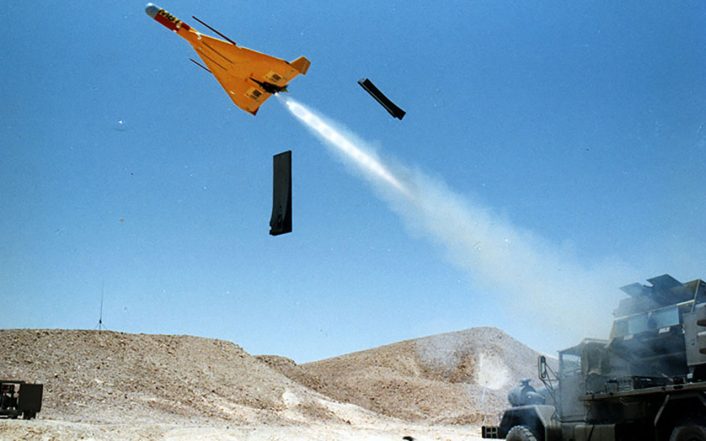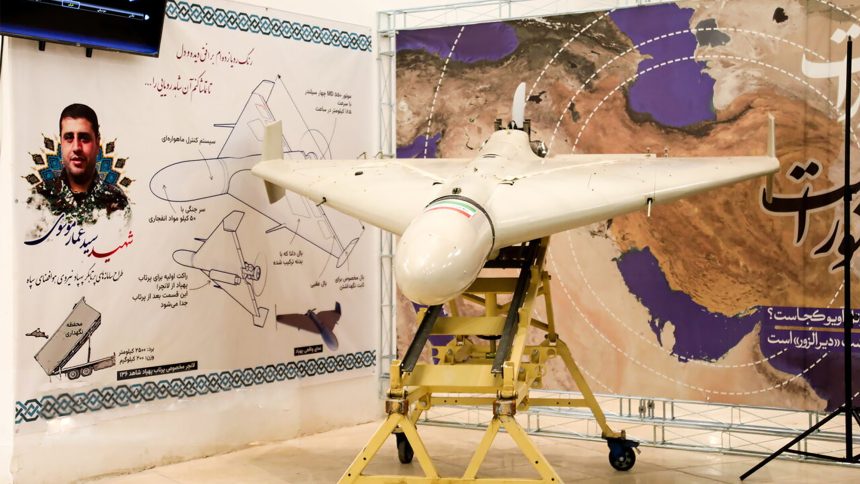An RFI was released by the U.S. Government describing the requirement for 1:1 reverse-engineered copies of Iran’s Shahed-136 attack drone, also used by Russia, to be used to inform counter UAS tactics and technologies.
Stars and Stripes reported on the request for information (RFI) on Aug. 20, 2025, noting that the mass-produced Shahed family of drones has been deployed in large numbers by Russia against Ukraine – sometimes numbering 140 sorties per day. The Shahed-136, specifically, is a propeller-powered delta wing aircraft weighing in around 200 kilograms, with a payload of 50 kilograms. It usually functions as a simple one-way attack UAV, destroying itself when striking its target. There are suggestions that a variant with a loiter capability are available, but this has not been included as a requirement in the RFI.
Usually we only see the russian Geran-2 (Shahed 136) drones after they have been shot down. Here is a photo of an intact one on display. pic.twitter.com/RjzMGmX3JL
— DanielR (@DanielR33187703) August 12, 2025
Known in Russian service as Geran-2, the Shahed-136 is usually launched from the ground or from vehicles, sometimes with assistance from a rocket to allow a near vertical launch. This allows a single vehicle to carry a number of Shahed-136s at once, and launch in quick succession with a view to overwhelm and confuse opposing air defences.
Iran has published the various launch systems of Shahed-136s loitering munitions for the first time pic.twitter.com/eO2VBWxFma
— Iran Observer (@IranObserver0) November 13, 2023
Submissions from industry must deliver a “1:1 copy”, mirroring the form, fit, and function of the Shahed-136. This means specifications that provide a minimum range of 2,500km+, speed up to 185km/h, length of 3.5 metres and width of 2.5 metres. The copies must also be propeller powered of the same size and in the same position as the one used on the original drone. They will be launched pneumatically and fly autonomously from takeoff to landing.
No example of the Shahed-136 will be provided to industry in order to inform proposals, so any interested parties must be able to develop their submission independently. The initial buy is projected to include 16 airframes, with a follow-on order option for 20 additional units.
Rather than incorporating the drones into its own arsenal, the copycat drones would be used as surrogates for actual Shahed-136s in training exercises and developmental trials. This is to ensure that U.S. military practices and technology would be able to effectively counter the drone in real life scenarios.
Companies are encouraged to submit both clean-sheet designs as well as designs that they may already have in development. This could lead to dual-role designs where a variant is produced for training purposes while another is developed for use as a frontline weapon. The merits of one-way attack UAVs has not been lost on Western armed forces, although many have been relatively slow in publicly adopting such weapons. Manufacturers like MBDA are now introducing advanced concepts of this type into their product lineups.
MQM-172 Arrowhead
Almost certain to be submitted as a contender in this RFI and any future tender processes is Griffon Aerospace’s MQM-172 Arrowhead. The Arrowhead, as suggested above, is intended both as a target drone as well as a frontline weapon. Many commentators have remarked on the platform’s similarity to the Shahed-136, even calling it an unlicensed copy. First unveiled earlier this month, the Arrowhead is said to be ‘enhanced’ over the Shahed-136 that it takes inspiration from.
These images show unlicensed copies of the Iranian Shahed-136 one-way attack drone, produced by Griffon Aerospace in the United States under the designation MQM-172 Arrowhead. They are employed both as one-way attack drones and as target drones. pic.twitter.com/uFPINXPUq0
— Babak Taghvaee – The Crisis Watch (@BabakTaghvaee1) August 20, 2025
Like the Shahed, Griffon says their drone can be launched pneumatically, as well as with rocket assistance. The listed payload, which could include an explosive warhead, electronic warfare technology, or intelligence, surveillance, reconnaissance equipment, is 100 lbs, or around 45 kg.
Griffon is well versed in the field of unmanned aircraft, having delivered over 12,000 systems as of 2025. The company primarily focuses on smaller platforms which, while important for their use cases, receive little attention compared to the larger aircraft that are the bread and butter of industry giants like GA-ASI.
LUCAS
Before the Arrowhead came the Low-Cost Uncrewed Combat Attack System (LUCAS), developed by Spektreworks. Inside the company, the drone has been given the designation FLM 136 – a clear reference to the design that inspired its development. LUCAS was designed from the outset to be used in the threat emulation role, however its current iteration falls short of some of the Shahed-136’s performance characteristics, which could make it unsuitable for this RFI. The small, Arizona-based company would likely need to produce an upgraded variant in order to be competitive.
Here’s the Spec Sheet for the FLM 136 I assume the LUCAS drone is based on. About 400 miles of range, 40 pound payload, with an engine that’s about half the displacement of the Shahed 136’s. pic.twitter.com/U4oe8RoZX1
— Alex Hollings (@AlexHollings52) July 17, 2025
Notably, though both these drones trace their lineage to the Shahed-136, the Shahed-136 itself borrowed heavily from elsewhere. The Iranian drone is thought to have been heavily inspired by the Dornier Die Drohne Antiradar, or DAR, which was developed in the 1980s under a plan to overwhelm Soviet air defences. While the DAR never entered full scale production, it is thought that the design was picked up by Israel Aerospace Industries to form the basis of the IAI Harpy.

Iran would have had many opportunities through its various proxies throughout the Middle East to acquire malfunctioning Harpy drones, or even simply copy the design from available images/video, and reverse-engineer them into their own Shahed variants. As development has diverged over the years, though, even closely related platforms can eventually become very different from one another, necessitating further reverse-engineering of reverse-engineered designs.









